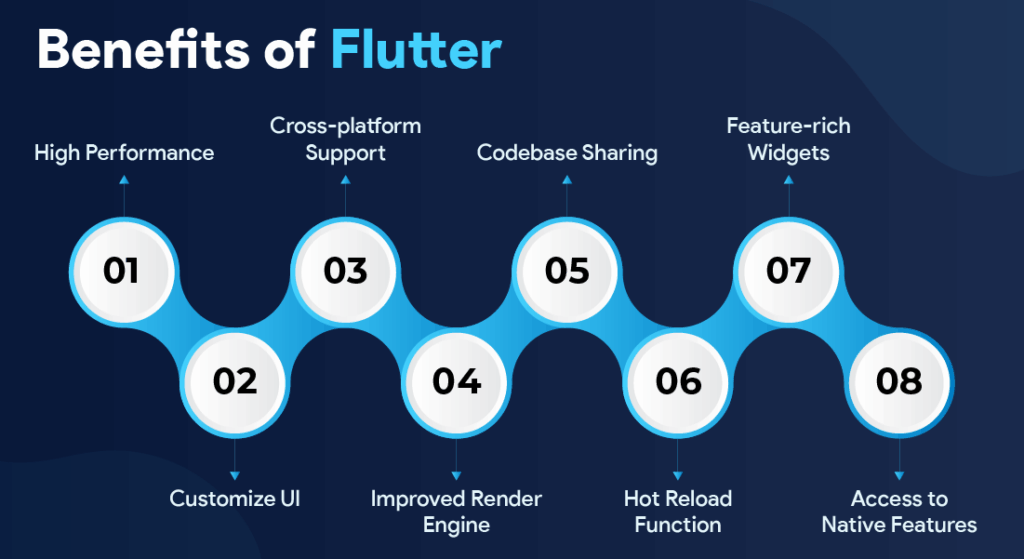Flutter, Google’s open-source UI framework, remains a top choice for app development in 2025. Its versatility and efficiency empower businesses to create robust, user-friendly applications.Discover why Flutter is the top choice for cross-platform app development in 2025. From faster development and reduced costs to native-like performance and beautiful UI, explore 13 compelling reasons businesses are switching to Flutter to build scalable, high-performance apps.
what is flutter?
Flutter is an open-source UI software development kit (SDK) created by Google. It enables developers to build high-performance, cross-platform applications from a single codebase — meaning one set of code runs on both Android and iOS, as well as web and desktop platforms. Since its release in 2017, Flutter has rapidly grown in popularity due to its speed, flexibility, and visually rich design capabilities.
Flutter uses the Dart programming language, also developed by Google. Dart is optimized for fast apps on multiple platforms, and its learning curve is relatively friendly for developers familiar with object-oriented programming.
key Features of Flutter
1. Single Codebase for Multiple Platforms
One of Flutter’s most praised advantages is its ability to write once and run everywhere. Instead of maintaining separate codebases for Android, iOS, web, and desktop apps, developers can manage just one — reducing development time and cost dramatically.
2. Hot Reload for Fast Iteration
Flutter supports hot reload, a powerful feature that allows developers to see the results of their code changes instantly without restarting the app. This accelerates development, debugging, and UI experimentation.
3. Rich Widget Library
Flutter is built around the concept of widgets — everything in Flutter is a widget. It comes with a wide variety of pre-built and customizable widgets, allowing developers to create visually stunning apps that look and feel native to each platform.
4. Native Performance
Unlike some cross-platform frameworks that rely on JavaScript bridges, Flutter compiles to native ARM code using Dart and the Skia graphics engine. This results in smooth animations, fast performance, and responsive UI — all comparable to natively built apps.
13 Benefits of Flutter to Shape Your Business in 2025

Discover how Flutter is transforming the future of mobile and web app development in 2025. In this article, we explore the 13 key benefits of Flutter that make it the go-to framework for startups, SMEs, and enterprises alike. From faster time to market and lower development costs to cross-platform efficiency and stunning UI capabilities — learn why choosing Flutter can give your business a competitive edge in the digital era.
1. Single Codebase for Multiple Platforms
Flutter allows developers to write one codebase for iOS, Android, web, desktop, and even embedded devices, streamlining development and reducing costs.
2. Accelerated Development with Hot Reload
The hot reload feature enables real-time code updates, allowing developers to see changes instantly. This speeds up iteration cycles and shortens time-to-market.
3. Native-Like Performance
Compiled to native code using Dart and powered by the Skia graphics engine, Flutter delivers high-performance apps with smooth animations and fast load times.
4. Cost-Effective Development
A unified codebase eliminates the need for separate platform-specific teams, significantly cutting development and maintenance expenses for businesses.
5. Highly Customizable UI
Flutter’s widget-based system offers extensive customization, enabling developers to craft visually stunning, brand-consistent interfaces tailored to user preferences.
6. Robust Ecosystem and Libraries
Flutter’s growing ecosystem includes a vast array of packages and plugins, simplifying integration with cutting-edge technologies like AI, AR, and cloud services.
7. Seamless Third-Party Integrations
Flutter supports easy integration with Firebase, APIs, and other third-party tools, enabling features like analytics, push notifications, and payment gateways.
8. Scalable Architecture
Flutter’s modular design ensures apps can handle growing user bases and complex features, making it suitable for startups and large enterprises alike.
9. Simplified Testing
A single codebase reduces the need for extensive platform-specific testing, saving time and resources while ensuring consistent app quality.
10. Enhanced Developer Productivity
Dart’s clean syntax, combined with Flutter’s comprehensive documentation and tooling, boosts developer efficiency, allowing focus on innovation.
11. Strong Community and Google Support
Backed by Google and a thriving global community, Flutter benefits from frequent updates, reliable resources, and long-term stability.
12. Future-Ready Technology
Flutter’s adaptability to emerging trends, such as foldable devices and wearable tech, ensures your app remains relevant in 2025 and beyond.
13. Improved User Engagement
With fast performance, smooth animations, and intuitive UI, Flutter apps deliver exceptional user experiences, driving higher engagement and retention.
Choosing Flutter in 2025 equips businesses with a powerful, cost-efficient, and future-proof solution to build high-quality apps that meet modern demands.
Flutter includes two crucial components
Flutter, Google’s powerful UI toolkit, is built on two essential components that make cross-platform app development smooth and efficient
1. Flutter SDK (Software Development Kit)
The Flutter SDK is a collection of tools that helps you develop apps using the Dart language. It includes:
- Flutter Engine: The heart of Flutter that handles rendering, input, and core libraries. It uses the Skia graphics engine to draw widgets directly onto the screen, enabling smooth and native-like performance.
- Tools for compilation: It compiles Dart code into native ARM machine code for iOS and Android.
- Hot Reload Support: Enables quick testing and UI tweaks without restarting the app.
- DevTools: Provides debugging, performance tracking, and widget inspection.
2. Flutter Framework
The Flutter framework is a rich set of libraries and APIs built in Dart that you use to build your UI. It includes:
- Widgets: The building blocks of every Flutter app. You can combine or customize widgets to create expressive, flexible UI components.
- Material & Cupertino Libraries: Pre-designed UI elements for Android (Material Design) and iOS (Cupertino) platforms.
- Gesture and Animation Libraries: Easily add interactivity and motion to your apps.
Conclusion: Why Flutter Should Be Your Top Choice in 2025
In 2025, Flutter stands out as a premier choice for app development due to its unmatched versatility, efficiency, and future-ready capabilities. Its ability to deliver high-performance, cross-platform apps from a single codebase minimizes development costs and accelerates time-to-market, enabling businesses to stay agile in competitive markets. Flutter’s rich widget library and seamless integrations with modern technologies like AI, IoT, and cloud services empower developers to create visually stunning, feature-rich applications tailored to brand needs. Backed by Google’s innovation and a vibrant global community, Flutter ensures scalability, reliability, and continuous updates, making it a future-proof investment. By choosing Flutter, businesses can build engaging, cost-effective, and scalable apps that drive growth and captivate users in 2025 and beyond.
Looking to build a Flutter app that performs beautifully across all platforms? Soumya IT Solution is here to help you every step of the way. Visit soumyaitsolution.com or call us at +91 8824415793 to get started

